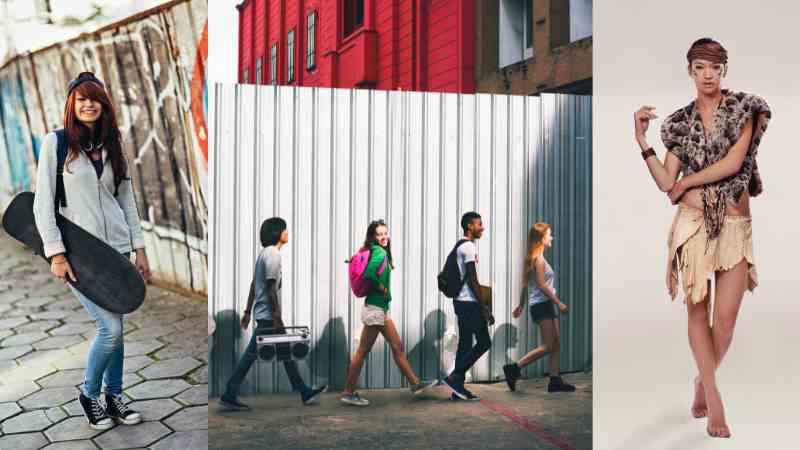The globalization of fashion has fundamentally transformed how clothing is designed, produced, and consumed across the globe. This interconnectedness has facilitated a vibrant exchange of styles, designs, and cultural influences, creating a dynamic and ever-evolving fashion landscape. This post delves into the impact of globalization on fashion trends around the world. We will explore how cultural exchange, technological advancements, and industry practices have intertwined to shape modern fashion. Through engaging examples and a storytelling approach, we will uncover the significant impact of globalization on the fashion industry.
What is the Globalization of Fashion?
How Has Fashion Become Globalized?
Globalization of fashion refers to the increasing interconnectedness of fashion markets and practices across different countries and cultures. This phenomenon has accelerated dramatically over recent decades, driven by advancements in technology and global trade.
Historically, fashion trends and designs spread slowly. Before the advent of global trade and technology, it took months or even years for fashion trends from one region to influence others. For instance, the fashion week in Paris might take a year to reach the boutiques in New York City.
Today, thanks to the rise of e-commerce and social media, fashion moves rapidly across the globe. Platforms like Instagram and TikTok allow trends to emerge and spread in real time. For example, a new streetwear style showcased in Tokyo can become a global trend within weeks, influencing designers and retailers worldwide.
Why is Globalization Important in Fashion?
The importance of globalization in fashion lies in its ability to broaden the fashion industry‘s reach. It has made fashion trends accessible to a global audience, fostering a rich cultural exchange. Designers from different countries now have the opportunity to influence each other’s styles and designs.
For instance, the influence of Japanese streetwear on Western fashion is a clear example of this cultural exchange. Designers like Rei Kawakubo and Yohji Yamamoto have introduced unique elements of Japanese aesthetics to the global fashion scene, blending traditional Japanese clothing with contemporary Western styles.
Consumers benefit from this interconnectedness by enjoying a wider variety of clothing options. The availability of diverse styles reflects a broader spectrum of cultures and aesthetics from around the world, enhancing the shopping experience and broadening fashion choices.
Influences of Globalization on Fashion Trends
Cultural Exchange and Fashion Trends
Cultural exchange plays a significant role in the globalization of fashion. As designers and brands interact across borders, they draw inspiration from traditional clothing and materials from various cultures, creating new styles that resonate with global consumers.
For example, the influence of African prints and textiles on Western fashion is profound. Designers such as Stella Jean and Balenciaga have incorporated vibrant African patterns and fabrics into their collections, highlighting the impact of cross-cultural influences on global trends.
Another example is the incorporation of Indian textiles into high fashion. Designers like Sabyasachi Mukherjee have brought traditional Indian fabrics and embroidery techniques to international runways, showcasing the value of cultural exchange in fashion.
Technology and Fashion Globalization
Technology has been a major driver of the globalization of fashion. Innovations such as 3D printing, virtual fashion shows, and augmented reality are transforming how clothing is designed, produced, and marketed.
Social media platforms like Instagram and TikTok have democratized fashion by allowing new designers and brands from all over the world to showcase their products. These platforms enable instant feedback from a global audience, allowing trends to emerge and evolve rapidly.
For instance, the rise of Instagram influencers has significantly impacted fashion trends. Influencers such as Chiara Ferragni and Aimee Song have become trendsetters, with their styles influencing millions of followers worldwide and shaping the direction of fashion.
Fast Fashion and Global Supply Chains
The rise of fast fashion has dramatically impacted the fashion industry. Brands like Zara and H&M operate on a global assembly line, producing clothing at a rapid pace to keep up with the latest trends. This model relies on global supply chains, where labor and production are outsourced to developing countries.
The focus of fast fashion is on efficiency and affordability. However, this approach raises concerns about sustainability and fair labor practices. Reports from organizations like the World Bank have highlighted issues related to sweatshops and low wages in the supply chains of fast fashion retailers.
For instance, the 2013 Rana Plaza collapse in Bangladesh, which killed over 1,100 workers, exposed the harsh realities of the fast fashion industry and sparked global conversations about ethical labor practices and the environmental impact of clothing production.
Regional Fashion Trends Influenced by Globalization
North America
In North America, the influence of globalization is evident in the rise of streetwear and luxury fashion. Cities like New York and Los Angeles are fashion hubs where global trends merge with local styles.
Brands such as Nike and Ralph Lauren reflect a blend of American and international influences in their collections. Nike’s collaborations with designers from different cultures have led to the creation of unique products that appeal to a global audience.
The fashion weeks in New York and Los Angeles showcase a diverse range of designs, reflecting both American trends and international influences. The incorporation of global elements into these fashion events highlights the dynamic nature of the North American fashion scene.
Europe
European fashion is deeply intertwined with global trends. Paris and Milan are renowned for their fashion weeks, which showcase designs that blend traditional European aesthetics with global influences.
Designers like Gianni Versace and Christian Dior have set benchmarks for high fashion by incorporating elements from various cultures into their creations. Dior’s use of Japanese silk and Versace’s adoption of African prints are examples of how European designers blend international elements with their signature styles.
Asia
Asian fashion has gained significant traction in the global market. K-fashion, which includes brands from South Korea, and Chinese designers have achieved international acclaim. The influence of Asian styles is visible in global trends, ranging from streetwear to haute couture.
The rise of K-pop has also contributed to the popularity of K-fashion. Groups like BTS and BLACKPINK have become global fashion icons, with their distinctive styles influencing trends around the world. Chinese designers such as Guo Pei and Han Wen are making waves in the international fashion scene with their innovative designs.
Africa
African fashion is making waves globally, with designers from the continent gaining recognition for their unique styles and materials. The rise of African fashion brands and designers has introduced vibrant colors and innovative designs to the international fashion scene.
Designers like Ozwald Boateng and Lisa Folawiyo have brought African textiles and traditional craftsmanship to the global stage. Their work showcases the impact of cultural exchange and highlights the growing influence of African fashion on the international market.
The Future of Globalized Fashion
Sustainability and Ethical Fashion
As the fashion industry becomes more globalized, there is a growing emphasis on sustainable practices. Brands are increasingly adopting eco-friendly materials and promoting fair labor practices. The shift towards sustainable fashion reflects consumer demand for greater transparency and responsibility from fashion brands.
Sustainability is becoming a key factor in the globalization of fashion. Reports from organizations like the World Resources Institute have highlighted the environmental impact of fashion and the need for more sustainable practices. Brands like Stella McCartney and Patagonia are leading the way in adopting eco-friendly materials and promoting ethical practices in their production processes.
Technological Innovations
The future of globalized fashion will be shaped by technological innovations. 3D printing, virtual fashion shows, and augmented reality are transforming how clothing is designed and marketed. These technologies are making fashion more accessible and customizable, allowing consumers to experience global trends in new and exciting ways.
3D printing is revolutionizing clothing production by enabling designers to create intricate designs with precision and efficiency. Virtual fashion shows allow brands to showcase their collections to a global audience without the constraints of physical runway events. Augmented reality is enhancing the shopping experience by allowing consumers to visualize how clothes will look on them before making a purchase.
Predictions for Future Trends
Looking ahead, globalization will continue to drive fashion trends, with cross-cultural influences and technological advancements playing major roles. We can expect further innovation in clothing production, materials, and designs, reflecting the ever-evolving nature of the global fashion landscape.
Emerging trends such as slow fashion and the use of closed-loop production methods are expected to gain traction as consumers become more conscious of sustainability. The integration of artificial intelligence in fashion design and marketing will further shape the future of the industry, creating new opportunities and challenges for designers and brands.
FAQs
What is Globalization in Fashion?
Globalization in fashion refers to the integration and exchange of fashion trends and styles across different cultures and countries. It involves the worldwide spread of clothing trends, designs, and brands, driven by technology and global trade.
How Does Globalization Affect Fashion Trends?
Globalization influences fashion trends by facilitating the exchange of designs and styles between cultures. Trends from one part of the world can quickly spread to others, creating a dynamic and diverse fashion landscape.
Who Benefits from the Globalization of Fashion?
Designers, brands, and consumers all benefit from the globalization of fashion. Designers gain access to a broader market, brands expand their reach, and consumers enjoy a wider variety of clothing options.
What are the Challenges of Globalized Fashion?
Challenges of globalized fashion include issues related to sustainability, cultural appropriation, and fair labor practices. The fashion industry must address these challenges to ensure that the benefits of globalization are balanced with ethical and environmental considerations.
Conclusion
The globalization of fashion has revolutionized the industry, merging styles, designs, and trends from around the world. The ongoing cultural exchange and technological advancements continue to shape the future of fashion, making it an exciting and dynamic field.
As consumers and industry professionals, we should embrace the diversity and innovation brought about by globalization while being mindful of its challenges and opportunities. The future of fashion will be defined by its ability to adapt to evolving trends and the ongoing integration of global influences.
More Post
The Secret of Scarves: Transforming Outfits with a Simple Accessory
The Perfect Lace Party Dress: How to Find It?
What is The Role of Fashion in Rites of Passage?



